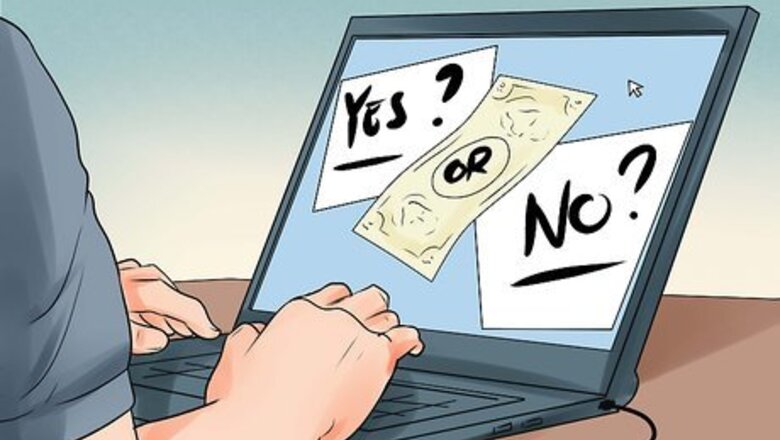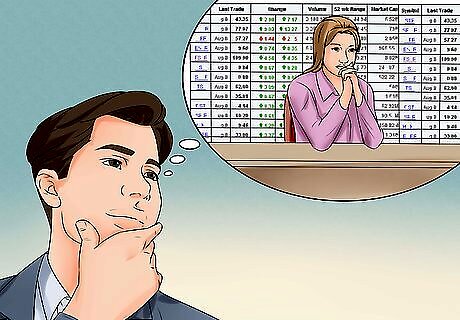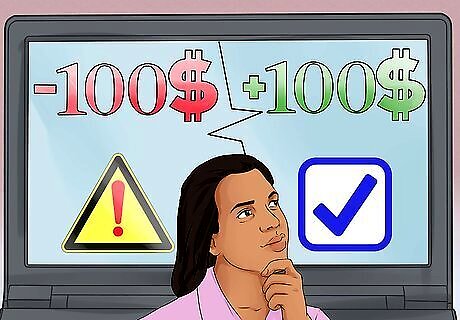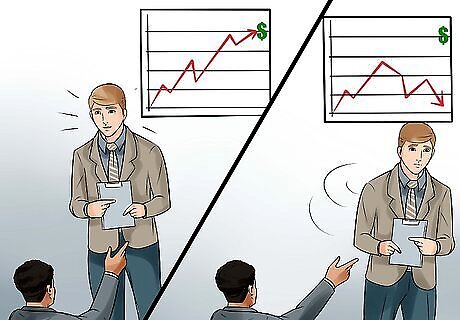
views
Understanding the Rules of the Game

Know the meaning of a binary option. A binary option is based on a “yes” or “no” proposition to whether an underlying asset will be above a certain price at a specified time. If you answer yes and are correct at the time of expiry, you win and are “in the money.” If you answer no and lose, you lose the money you invested. You're “out of the money.” However, unlike other options, you can only make or lose up to $100 per options contract. An underlying asset in binary options trading can be a specific company's stock; a commodity like gold; a stock index like the S&P 500 Index; Bitcoin; a Forex pairing, which is the value of one foreign currency against another; or a news event, such as whether the Federal Reserve will increase or decrease rates. "In the money” and “out of the money” simply refer to whether you answered the proposition a) correctly and are “in the money” or b) incorrectly and are “out of the money.” The expiry date is the time or date at which the binary option expires, and the price is examined to see if it increased or decreased. It can be anywhere from five minutes to over a month after you placed the trade.

Recognize it's an “all-or-nothing” deal. Just like rolling the dice in a game of craps, you either win the pot or lose what you put in the pot. For example, if the proposition is, “Will the price of gold be above $1,150 by 1:30 p.m. today?” and you decide yes it will be, you would place a binary call option. If the option were trading at $35 (bid price) and $37.50 (ask price) at 1 p.m., you'd buy at $37.50. (If you were selling, you'd sell at $35.) If you're correct at 1:30 p.m. and the price of gold is above $1,150, your option is now worth $100. Your profit, then, is calculated like this: $100 (total amount you can make on one trading contract) - $37.50 (the price you paid for that contract) = $62.50 minus fees. You're in the money. So, for every winner, there's a loser on the other end. It's a zero-sum game. A call option is essentially when you predict that the underlying asset will increase in price. Even if an underlying asset only increases by a tenth of a cent you still win in binary options trading. A put option is when you predict that the underlying asset will decrease in price. Here again you win even if the underlying asset only drops by just a tick. The bid price is the maximum price that a buyer or buyers are willing to pay for an underlying asset. The ask price is the minimum amount a seller or sellers are willing to receive for an underlying asset. A trade or a transaction results when the two agree on a price.

Realize that market makers determine the bid and ask prices. Market makers – or a person or brokerage house/bank – look at many variables to decide whether they believe the proposition will be true or false and are fairly confident they're on the winning side. If the bid and ask are in the likes of $85 and $89, respectively, market makers are assuming there's a high probability that the proposition will result in a yes. If the bid and ask are near $50, that's saying they're not sure. If the bid and the ask are more like $10 and $15, they're indicating they think the answer will be no.

Understand you don't own the underlying asset. Binary options trading merely involves speculation on the price of the underlying asset. It does not mean you own the asset itself. For example, when you buy a binary options contract you don't own stock in Google or own a certain amount of gold.

Recognize the risk and reward in relation to other options trading. When trading in binary options, the gain or loss is fixed at $100 per options contract. In general options trading, the same isn't true. But that alone doesn't account for the difference. In options trading, one has to calculate the direction of the price as is required in binary options trading and the magnitude of the price move. Thus in binary options trading there is more assured reward and a capped risk. Your profit or loss isn't determined by the price of the underlying asset at the time of expiry as it is with other options.
Exercising Options

Learn about exercising options. There are two types of binary exercising options: the American style and the European style. American-style options can be exercised (or settled) at any time prior to expiry. European-style options can only be exercised on the date of expiry or the last business day prior to expiry. With both in binary trading, you can change your position if you think your initial answer to the proposition will be wrong at expiry to a) cut your losses or b) lock in an early profit.

Know the three legal binary options contract markets in the U.S. Due to widespread fraud involving binary options trading on Internet-based platforms, the U.S. Commodity Futures Trading Commission approved three markets or exchanges for trading binary options: Nadex, the Chicago Board Options Exchange and the Cantor Exchange. You can make direct trades on each. Each has its own, very specific rules. Make sure you read them first.

Take measures to avoid dealing with fraudulent operations. Much of the binary options trading market operates online, and many are not in compliance with U.S. regulations. It's recommended you do the following before trading with entities other than the three exchanges. Check to see if the platform has registered with the Securities and Exchange Commission (SEC) by checking its Electronic Data Gathering, Analysis, and Retrieval system (EDGAR), which you can access here: [1]. Determine if the platform itself is registered as an exchange by looking at the SEC's website on exchanges located here: [2]. Find out if the platform is a designated contract market by checking the U.S. Commodity Futures Trading Commission's (CFTC) list here: [3]. Finally, check the registration status and background of any firm or financial professional by checking these two websites, the Financial Industry Regulatory Authority's BrokerCheck and the CFTC's fraud advisories: [4] and [5].

Know the exercise options and fees of each exchange. The CBOE uses the European style, and options can only be exercised on the last business day prior to the date of expiry. However, it allows you to sell or buy back your position prior to expiry. Nadex uses the American style, as does the Cantor Exchange. Each of their fees differ as all, and this should be considered and calculated before trading. The Cantor Exchange doesn't charge per trade. It does charge $.90 per contract at settlement if you're in the money. There's no charge at expiry if you're out of the money, and a $.45 charge if you're at the money. This means there's been no change in the price, so you neither win nor lose. Nadex charges both trading and settlement fees. Trading fees are assessed twice – once to open and once to close a trade. It charges $.90 per contract up to 10 contracts; there are no fees per contract after that, so your total trading fee for each side of the trade is capped at $9.00. It charges $.90 per contract settlement (up to 10) that's in the money. There are no fees if you're out of the money. The CBOE fees vary. Other platforms that trade through these exchanges charge fees, too, generally on top of the fees each exchange charges. Read the fine print carefully when using these platforms.
Maximizing Profits Strategically

Analyze markets through fundamental analysis. In broad terms, fundamental analysis is the study of all the external factors that can change the price of an asset. It looks at geo-political news like conflicts, elections, growth reports, employment, interest rate changes, etc. to then “ride the market's movement” and hopefully profit. It requires research – reading the news, studying world events, knowing the underlying trends in the markets you're trading, and the real situation on the ground as much as possible. For example, if you're trading on the release of employment data in Canada, you can't go off of predictions that it will, for instance, rise. You also need to look at the types of jobs that were added, how many hours workers put in, who's getting the jobs, etc. These will help you assess whether the price of the underlying asset – employment – rises or falls. Employment might rise, but the trading price may go down because of these other factors.

Utilize technical analysis. Technical analysis involves using tools – typically graphical charts – to pull together statistics on a) trends such as new highs and lows for specific issues (stocks, commodities or currencies), b) the speed at which an asset's price rises or falls, which represents momentum, c) the volume and number of both declining and rising issues, and d) whether an asset is trading either above or below average, which indicates volatility. Typically it involves looking at this all from a historical perspective to make predictions about future trends. The underlying suppositions in technical analysis are: the price of an asset is a reflection of all you need to know about that market; prices move according to trends; and history repeats itself. It's concerned with internal factors – price and past performance. Look at the New York Stock Exchange's advance-decline breadth indicator, the Arm's Index and the Trader's Short-Term Index when examining market movement over time. Use these indicators for trends in high and lows: Moving Averages and Parabolic SAR (stop and reverse). Examine the Relative Strength Index (RSI), the Commodity Channel Index (CCI) and stochastics oscillators to assess momentum. Study Bollinger bands, standard deviations and the Average True Range indicator for insight on volatility. Analyze the On Balance Volume (OBV), the Chaikin Oscillator, and the Rate of Change Volume (ROCV) indicator for market volume.

Examine market sentiment. Market sentiment is typically indicated by bullish behavior, such as buying call options and selling put options. It is also expressed by bearish behavior, such as buying put options or selling call options. Calculating the put-to-call ratio is a measure of market sentiment. To calculate this, divide the put volume by the call volume. When the ratio is low, you have a bearish market in which people are fearful. High ratios indicate the opposite. All major exchanges publish their own versions of these ratios. They focus on equity, indices, retail activity and so forth. Your goal is to find the ratio that applies to the underlying asset you're considering trading on and use it to direct your answer to the proposition.

Sniff out fear. Because people pull out when they're nervous, markets drop faster than they rise. Exchanges recognize this and even publish volatility indexes that you can use to help in your decision-making. You can also actually trade binary volatility options on the Chicago Board Options Exchange Volatility Index (VIX).

Trade on volatility. Because volatility drives the sale and price of options and trading stock normally in a volatile market is risky, consider trading binary options on the volatility of the underlying market. The first way is by buying or selling a market's direction at strike prices that are out of the money. This means they are cheaper. If you're the buyer and the strike price – the price of the underlying asset when the option is purchased – is higher at expiry, you win. If you're the seller and the strike price is below at expiry you win. The second way is trading binaries that are in the money in what you believe will remain a flat market. The initial cost will be more, but if your prediction is correct and the market remains flat you will make a small profit.

Consider the ask size when trading. The ask size is the number of contracts for an underlying asset that a market maker is offering to sell at the ask price. The market maker fills a customer's order with the lowest ask price for buys and the highest bid price for sells. The higher the ask size the larger the supply of that underlying asset there is that the market maker wants to sell. A large supply means you may have more leverage in paying a lower price for the option. Remember, you don't have to pay the ask price. You simply need to exceed the current bid and hope it's accepted before you're outbid.

Take advantage of the knock-off effect. This strategy is generally referred to as the Knock-Off Effect or Market Pull strategy. It's grounded in the assumption that the movement of one binary option will impact another. For instance, historically the price of gold drops when the US dollar (USD) rises, and the USD impacts how other currencies fare on the market. Your task is to learn about and monitor the markets for these correlations before placing a put or call. It uses both fundamental and technical analysis to determine your trade and is considered by some the most effective way to make money when trading binary options.

Hedge existing positions. Buying binary put options on stocks you already own but think may drop in price a bit could offset losses in those stocks if they did, indeed, fall. This wouldn't protect you if the stock dropped significantly. It could help though if the dip was small-to-moderate. You can also hedge on losing binary positions by using shorter-term expiry binaries such as a five-minute binary. Placing a put option in the direction of the loss can help you recoup your other loss as long as the asset continues moving in the losing direction.




















Comments
0 comment